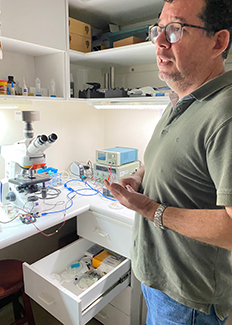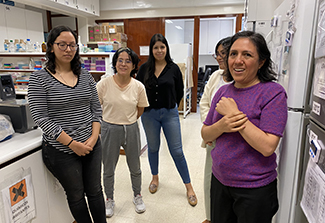Peru’s research infrastructure, supported by Fogarty, continues to blossom
July/August 2023 | Volume 22 Number 4
 Photo credit: Fogarty International CenterDr. Mirko Zimic, former trainee in Fogarty’s GID program, runs the Laboratory of Bioinformatics at UPCH. His lab developed low-cost versions of inverted microscopes with 3D printing.
Photo credit: Fogarty International CenterDr. Mirko Zimic, former trainee in Fogarty’s GID program, runs the Laboratory of Bioinformatics at UPCH. His lab developed low-cost versions of inverted microscopes with 3D printing.
During the early years of the AIDS epidemic, Fogarty pivoted from training mostly European researchers to building and strengthening research capacity in low- and middle-income countries. It was within that context that Fogarty-supported training programs in Peru began in earnest during the early 1990s. These initial programs, which combined training with research, aimed to develop a network of health scientists, while fostering collaborations with health research institutions both inside and outside the South American nation.
In the words of Dr. Andres “Willy" Lescano, a former Global Infectious Diseases (GID) program trainee, seeds planted decades ago “fell onto fertile ground." Thirty years later, former trainees and projects resulting from those original programs and partnerships continue to blossom.
Cultivating research & researchers
On a June 2023 trip to Lima, Acting Fogarty Director Dr. Peter Kilmarx met with several trainees of those early programs who have since become leaders in Peruvian health research. Kilmarx was joined by Dr. Richard Benson, director, and Stacey Chambers, scientific project manager, in the Office of Global Health and Health Disparities at the National Institute of Neurological Disorders and Stroke (NINDS), and Judy Coan-Stevens, then acting director of Fogarty’s Office of Communications. Together, the NIH group visited four important sites within the Peruvian research landscape.
The Center of Technological, Biomedical and Environmental Research at the National University of San Marcos, the Universidad Peruana Cayetano Heredia (UPCH), the Alexander von Humboldt Tropical Medicine Institute (IMTAvH), and IMPACTA Perú serve as hubs of research in Peru today. All have benefitted from various Fogarty programs via their leadership and employees.
For example, the AIDS International Training and Research Program (AITRP) supported some of Peru’s earliest Fogarty trainees. Former AITRP trainees include Dr. Jorge Alarcón, an executive director at the National University, and Dr. Carlos Cáceres Palacios, vice-president of research at UPCH. Another former trainee is Dr. Patty García, Peru’s former Minister of Health and the former dean of UPCH’s School of Public Health. Garcia, who continues to mentor trainees (primarily through Fogarty’s LAUNCH program), said, “Fogarty's investment in Peru has been catalytic.”
 Photo credit: Fogarty International CenterMonica Pajuelo (pictured, right), former trainee in Fogarty’s GID program, runs the Laboratory of Molecular Biology at UPCH. Several current Fogarty trainees work in the lab, including Lucero Merino (left, in striped shirt) and Andrea Diestra-Calderon (behind Pajuelo)
Photo credit: Fogarty International CenterMonica Pajuelo (pictured, right), former trainee in Fogarty’s GID program, runs the Laboratory of Molecular Biology at UPCH. Several current Fogarty trainees work in the lab, including Lucero Merino (left, in striped shirt) and Andrea Diestra-Calderon (behind Pajuelo)
Other Fogarty programs have also contributed to the educations of influential Peruvian scientists. Drs. Monica Pajuelo, Maribel Paredes, Patricia Sheen, Manuela Verastegui, and Mirko Zimic all received training through the GID program, while Dr. Stella Hartinger trained in Fogarty’s Environmental and Occupational Health program and Dr. Maritza Calderón Sanchez was a former Fogarty scholar. These seven scientists all run UPCH labs; between them, they’ve mentored 30 former and current Fogarty trainees.
Expansion beyond HIV/AIDS research
Dr. Mirko Zimic, a former GID trainee, focuses on bioinformatics. His lab has developed low-cost versions of inverted microscopes with 3D printing and
fluorescence microscopy using smartphones and off-the-shelf lasers. “I got the idea from a paper written by Howard Shapiro 15 years ago," said Zimic. Not many in the U.S. paid much attention to it, but for a country with limited resources, like Peru, it allows for highly accurate diagnosis of disease such as tuberculosis and Chagas without the high cost of conventional fluorescence microscopy.
Dr. Javier Lama counts himself among the AITRP alumni. Currently, he is the director of research for IMPACTA Perú, a clinical research center focused on HIV care and clinical trials, that regularly hosts Fogarty fellows and scholars. "The scholars reinvigorate us," said Lama. Current Fogarty fellow Juliet Bramante will work with Lama on comparing HIV-related and skin disease-related stigma in urban Lima with experiences of stigma in the rural Loreto region.
Dr. Theresa Ochoa, director of IMTAvH, was a GID trainee. IMTAvH is known for its Gorgas Course in Clinical Tropical Medicine, a nearly 30-year-old collaboration with the University of Alabama at Birmingham that trains scientists from all over the world. Ochoa is now a principal investigator on a GID grant,
Peru Vanderbilt – PREvention through VacciNation Training (PREVENT) program, which plans to support 10 trainees. The
PARACAS program, run by IMTAvH's Dr. Eduardo Gotuzzo, has provided doctoral-level implementation science mentored-research training to 14 researchers over the last decade.
Dr. Pablo Tsukayama, a former Fogarty Global Health Fellow, focuses on bioinformatics and building lab capacity in Peru. During the COVID pandemic, it was his lab that
identified the Lambda variant. His goal is to decentralize genomic sequencing to spread capacity beyond Lima to other parts of Peru, hopefully with help from a Fogarty training grant.
Peru’s future
In FY2022, Fogarty funded more than 20 separate Peru-based projects ranging from studies on the relationship between air pollution exposure and NCDs to evidence-based mental health interventions. Some like the Translational Research Development for Endemic Infectious Diseases of Amazonia, a partnership between IMTAvH and the University of California San Diego, bring the research training which has blossomed with Fogarty's support in the capital, Lima, to other areas of the country. Others hope to extend beyond to border nations, especially in the light of climate migration from places like Venezuela and the movement of viruses from jungle to dryer areas.
The research landscape in Peru has been improved by grants from Fogarty and other NIH institutes and centers, according to Lescano. Now an associate professor at UPCH and adjunct professor at Johns Hopkins University, he counts “generations of Peruvian scientists born out of Fogarty D43 (training) grants." These generations have contributed to scientific discovery and helped build infrastructure so that local doctors, health care providers and scientists can improve their skills, while advancing regional health.
More Information
Updated August 15, 2023
To view Adobe PDF files,
download current, free accessible plug-ins from Adobe's website.
Related Fogarty Programs
Related World Regions / Countries